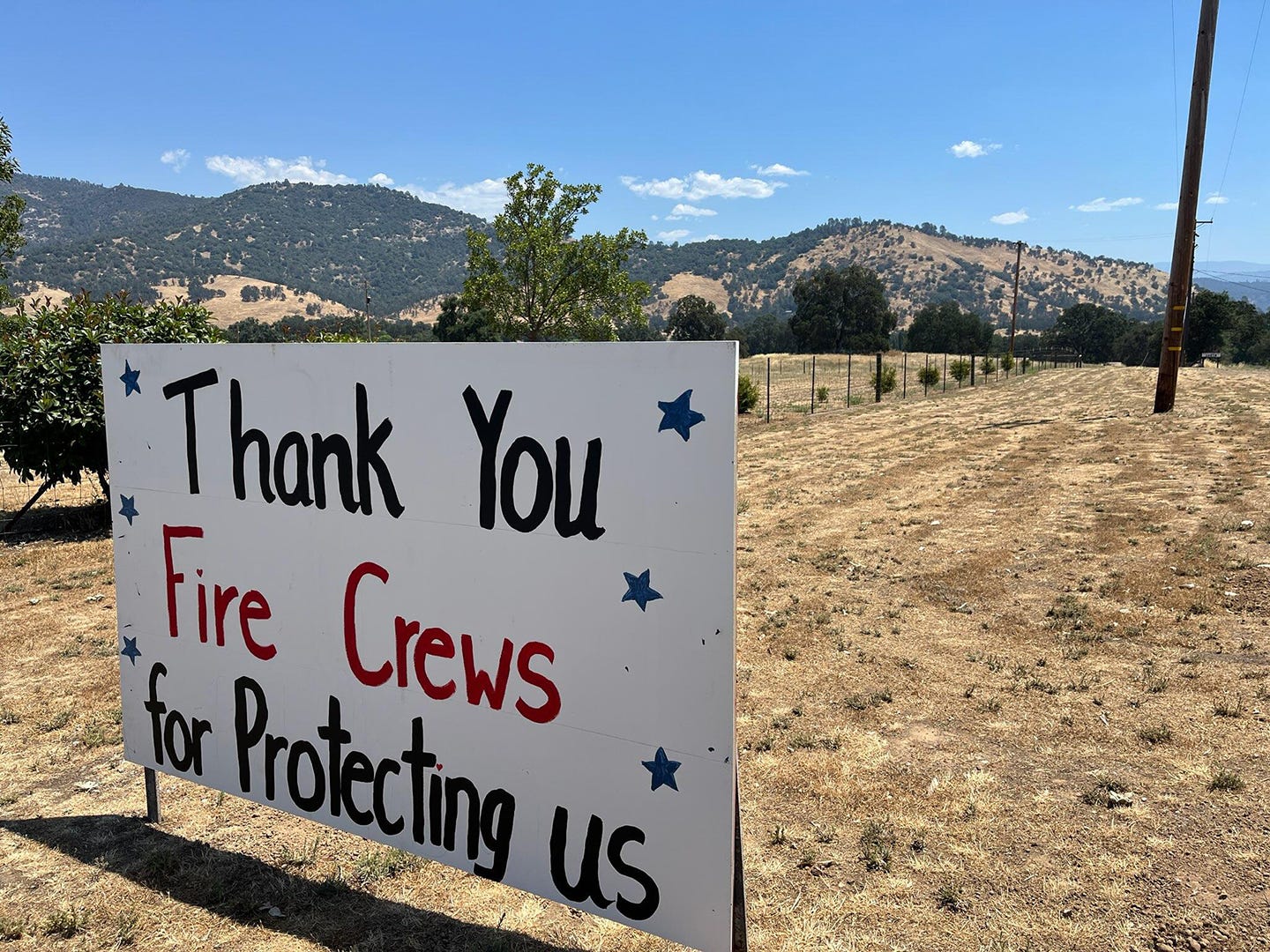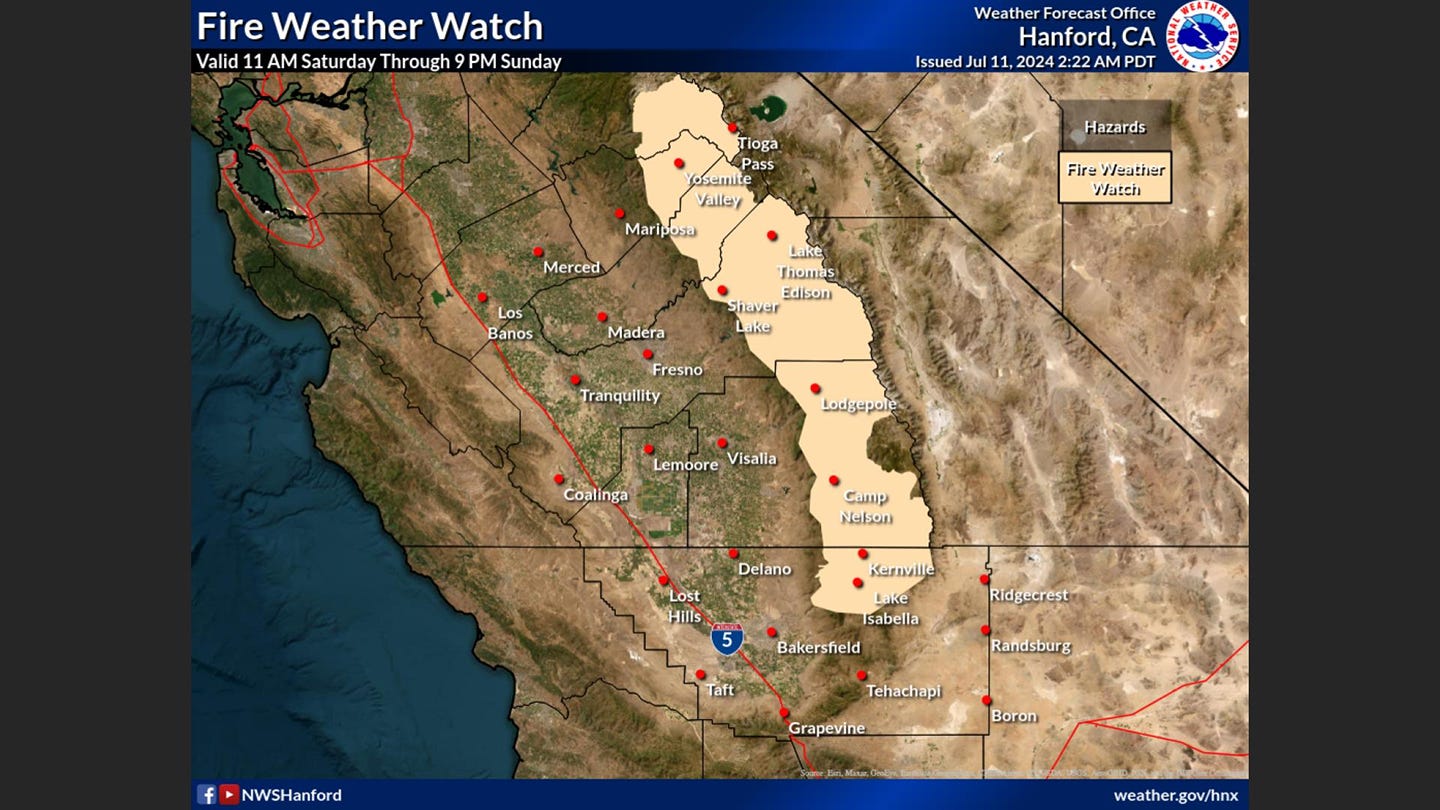Volume 2, Number 62 - Thursday, July 11, 2024
Published every Monday and Thursday

Perspective
“FORWARD PROGRESS STOPPED” are the words I always like to see when I check out a wildfire report, especially when temperatures are brutally high and in a year like this one with tons of dry vegetation ready to burn.
Yes, I understand that fire is a natural force in the Sierra Nevada, and that indigenous people used fire for many purposes. That said, as a bipartisan state commission found in 2018, “Instead of focusing almost solely on fire suppression, the state must institute wide-scale controlled burns and other strategic measures as a tool to reinvigorate forests, inhibit firestorms and help protect air and water quality.”
The Little Hoover Commission’s 2018 report “found that forest treatments should be accelerated and expanded throughout the Sierra Nevada and that there must be greater teamwork between state and federal forestry agencies to plan and implement the work. And, the state must create a long-term bioenergy plan to address the disposal of millions of dead trees as well as fund and develop a public education campaign about the importance of healthy forests in the Sierra Nevada.”
Since then, you probably know, California has seen shocking destruction and loss of life from wildfires — including many in the Sierra Nevada.
I was asked to speak at a recent meeting of the Kern-Kaweah Chapter of the Sierra Club in Bakersfield, and a member of the audience asked me what I thought were the top environmental concerns.
I can list many, but among them is the continued population growth in the WUI — wildland-urban interface. The gentleman who asked wasn’t familiar with that term, but someone else in the audience said, “Where the fires are.” If you look at CalFire’s fire map (HERE), I think you’ll see it’s true.
Actually, I think just about all of California is in the WUI. The Golden State is a beautiful place with lots of wild places. Take a look at the map with this 2022 article from the San Francisco Chronicle (gift link HERE) and you’ll see that nearly everyone in the state lives a relatively short distance from federal land.
Here’s an excerpt:
California is the third largest state in the country in terms of land area, with a total of more than 104 million acres. It’s also among the states where the U.S. government owns the highest percentage of land.
About 46% of California’s land area — or about 48 million acres — is owned by federal agencies, such as the Forest Service and Bureau of Land Management…. Much of the federally owned lands are for preservation, recreation and natural resources.
Add to that the wildlands set aside by the state and counties, and you’ll see that although many Californians live in densely populated urban areas, they’re surrounded by wildlands.
But back to wildfire …
California and tribal and federal partners have been making tremendous efforts to collaborate on the firefighting and fuel reduction fronts. Yes, one might always point to exceptions. Recently, as reported here, the National Park Service successfully completed planned burning in Kings Canyon National Park as Cal Fire and Fresno County dealt with a string of lightning fires just down the road. Sierra National Forest also worked to contain the Basin Fire, also not far away.
Meanwhile, Cal Fire and others have put down dozens of other wildfires throughout the state — and those efforts must continue until the wet season returns.
Cal Fire’s latest statistics for the 2024 season show 3,579 wildfires, one civilian fatality, 86 structures destroyed and 42 damaged and 219,247 acres burned.
Yesterday, as reported by the Mercury News HERE, Gov. Gavin Newsom warned Californians to be alert as the state heads into what could be a worse-than-expected fire season. This morning, the New York Times carried an article with the headline, “A Furious Start to California’s Fire Season; Some 207,000 acres have burned so far this year, more than five times the average.” You can read it HERE (gift link).
And here’s an update from the state about being prepared and the many innovations being used to detect, manage and fight wildfires — and keep the public informed: bit.ly/3Y0rM4e.
Giant sequoias and cultural burning in the NY Times
Save the Redwoods League’s recent burn in the Alder Creek grove was featured in the New York Times on Tuesday with fabulous photos and a great story full of information.
Fortunately, the NY Times offers gift links to subscribers, so I can share this entire article with you HERE. Enjoy!
Dwindling inmate firefighter crew story in LA Times
I subscribe to the LA Times also, but they don’t provide gift links. Fortunately, Yahoo carries LA Times work, so I’m able to share a link to their story on Tuesday about dwindling inmate firefighting crews in California. Inmates crews help with firefighting and forestry projects. You can read the story HERE.
Wildfire, water & weather update
Wildfires and excessive heat throughout California, as you probably already know. This morning’s report shows that the Basin Fire on Sierra National Forest is 14,020 acres and 92% contained. That’s a great improvement in containment from Monday. There’s a fire weather watch in the mountains this weekend. The best Sierra Nevada weather forecasts are at NWS Hanford, HERE, and NWS Sacramento, HERE.
Did you know you can comment here?
It’s easy to comment on items in this newsletter. Just scroll down, and you’ll find a comment box. You’re invited to join the conversation!
Thanks for reading!





Chad Hanson gave me permission to share his response to the NYT article linked above ...
Dear Editor:
I strongly support Native American cultural burning. Unfortunately, the New York Times sets up a false conflict between Tribal burning and mixed-intensity wildfires from lightning strikes (“To Protect Giant Sequoias, They Lit a Fire”, July 9, 2024). These wildfires usually include some higher-intensity fire patches, which the Times implies are categorically bad for giant sequoias. That's misleading.
A 1994 study released by the Forest Service found that giant sequoias depend on higher-intensity fire patches to effectively reproduce, noting that the “Giant sequoia is what is known as a ‘pioneer species,’ requiring canopy-destroying disturbance to complete its life cycle.” A 2011 study by Forest Service scientists found that giant sequoia regeneration was by far the highest in high-intensity fire areas. My own research published in 2024 finds the same thing.
To be clear, lower-intensity fire areas are natural too, and such areas have heavily dominated recent wildfires in giant sequoia groves. But it is only in the higher-intensity fire patches that we see the next generation of giant sequoias growing abundantly and thriving.
Tribal burning and mixed-intensity wildfires coexisted for millennia before colonization. They can coexist again in the future.
Chad Hanson, Ph.D., Research Ecologist
The entire state, minus some of the Wilderness areas and others that are remote (thinking PCH south of Ft Bragg), IS WUI.
Personally, we do study after study, commission after commission, and the answers are reports full of "recommendations" and "shoulds".
Funding? Action? "Naw dawg" goes the famous meme.
Highly qualified and experienced individuals like me are just sitting on the sidelines watching as homes burn down.
Hand me a couple landscaping companies worth of folks, and I will no joke roll into a town out ahead of a fire and leave most of it "defensible stand-alone" when we're done.
Yes, give me funds and folks and i can do that. Promise.
My phone and email are quiet though, and my attempts to try to help and inform people on other platforms are met with jokes and snarkasm, or arguments from Armchair FMOs who watched some fire shows on Netflix.